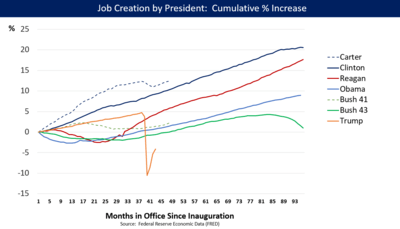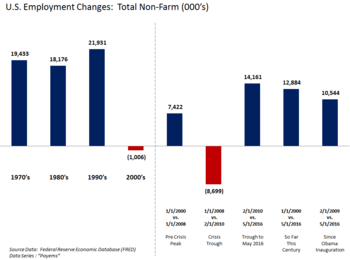Jobs created during U.S. presidential terms
Politicians and pundits frequently refer to the ability of the President of the United States to "create jobs" in the U.S. during his term in office.[1] The numbers are most often seen during the election season or in regard to a President's economic legacy. The numbers typically used and most frequently cited by economists are total nonfarm payroll employment numbers as collected by the Bureau of Labor Statistics on a monthly and annual basis. The BLS also provides numbers for private-sector non-farm employment and other subsets of the aggregate.

Among the Presidents from Jimmy Carter to Donald Trump, President Bill Clinton created the most jobs at 18.6 million, while Ronald Reagan had the largest cumulative percentage increase in jobs at 15.6%. This computation treats the base month as the December before the month of inauguration and last month as December of the final full year in office.[2] Using the month of inauguration as the base month as shown in the accompanying diagram, the top four Presidents in terms of cumulative job creation percentage are Clinton(D), Reagan(R), Carter(D), and Obama(D).[3]
Methodology
The jobs numbers are reported as part of the "Monthly Employment Situation Report" from the Bureau of Labor Statistics. The widely publicized "job creation" number is a net figure, computed as jobs created less jobs lost during the survey month. Estimates are generated via the "Establishment Survey", also known as the payroll survey or Current Employment Statistics (CES) program. The Establishment Survey as of May 2020 included "approximately 145,000 businesses and government agencies representing approximately 697,000 worksites." The Establishment Survey publishes jobs, hours, and earnings estimates at varying levels of detail (nation, state, metro area) and for different industries.[4]
The sample establishments are drawn from private non-farm businesses such as factories, offices, and stores, as well as federal, state, and local government entities. Employees on non-farm payrolls are those who received pay for any part of the reference pay period (which includes the 12th of the month), including persons on paid leave. Further, BLS explains that: "The CES employment series are estimates of nonfarm wage and salary jobs, not an estimate of employed persons; an individual with two jobs is counted twice by the payroll survey. The CES employment series excludes employees in agriculture, private households, and the self-employed." These monthly job counts are revised (sometimes by 20% or more) within 90 days to reflect additional data, seasonal adjustment models, and annual adjustments resulting from unemployment insurance filings. Figures are seasonally adjusted, which removes from the series the effects of normal variation from recurring events within a year, such as holidays and weather changes, and helps reveal underlying economic trends.[4]
Controversy

The exact usefulness of these numbers is debated. On the one hand, they include only nonfarm payroll employment, which excludes certain types of jobs, notably the self-employed. However, as a semi-balancing factor, they count one person with two jobs as two employed persons.
Additionally, for at least the first eight months of a President's term, he inherits a budget proposed and implemented by his predecessor (as well as an overall economy which may be in decline or recovery). The data in columns shown for September (in italic) correlate better with the federal fiscal year starting each October, showing the impact of a given president and resulting federal budget on the job count.
Moreover, according to the United States Constitution, the United States Congress is responsible for government spending and thus, regardless of Presidential advocacy, bears constitutional responsibility for such things as spending and tax policy that have enormous effects upon the economy. Furthermore, it is debatable how much effect any President realistically could have on a system as large, diverse, and complex as the U.S. economy. Nevertheless, the nonfarm payrolls number is the one most frequently used in the media and by economists, largely because the alternative (household survey numbers) is thought to drastically overestimate employment.
Another factor to consider is population growth, which provides opportunities for the creation of jobs, rendering these figures less impressive, or in the case of the already subpar, clearly insufficient.
The Heritage Foundation has pointed to Alan Greenspan's general economic optimism (in 2004) as support for household survey numbers over payroll numbers. However, the subsequent downturn, and Greenspan's admission of having been wrong, may have discredited that view.
Job creation by term



Numbers listed from 1941 and onward are BLS data[5] of nonfarm jobs (in thousands), and are shown from the year beginning and ending each presidential term. The monthly statistics are quoted from January, as U.S. presidents take office at the end of that month.
| U.S. president | Party | Term years | Start jobs | End jobs | Created | Ave annual increase |
|---|---|---|---|---|---|---|
| Harding/Coolidge | R | 1921–1925 | 25,000 ** | 29,500 ** | + 4,500 ** | +4.23% ** |
| Calvin Coolidge | R | 1925–1929 | 29,500 ** | 32,100 ** | + 2,600 ** | +2.13% ** |
| Herbert Hoover | R | 1929–1933 | 32,100 ** | 25,700 ** | -6,400 ** | -5.41% ** |
| Franklin Roosevelt | D | 1933–1937 | 25,700 ** | 31,200 ** | + 5,500 ** | +4.97% ** |
| Franklin Roosevelt | D | 1937–1941 | 31,200 ** | 34,480 ** | + 3,280 ** | +2.53% ** |
| Franklin Roosevelt | D | 1941–1945 | 34,480 | 41,903 | + 7,423 | +5.00% |
| Roosevelt/Truman | D | 1945–1949 | 41,903 | 44,675 | + 2,772 | +1.61% |
| Harry Truman | D | 1949–1953 | 44,675 | 50,145 | + 5,470 | +2.93% |
| Dwight Eisenhower | R | 1953–1957 | 50,145 | 52,888 | + 2,743 | +1.34% |
| Dwight Eisenhower | R | 1957–1961 | 52,888 | 53,683 | + 795 | +0.87% |
| Kennedy/Johnson | D | 1961–1965 | 53,683 | 59,583 | + 5,900 | +2.64% |
| Lyndon Johnson | D | 1965–1969 | 59,583 | 69,438 | + 9,855 | +3.90% |
| Richard Nixon | R | 1969–1973 | 69,438 | 76,621 | + 6,183 | +2.23% |
| Nixon/Ford | R | 1973–1977 | 76,621 | 80,692 | + 5,071 | +1.68% |
| Jimmy Carter | D | 1977–1981 | 80,692 | 91,037 | +10,345 | +3.21% |
| Ronald Reagan | R | 1981–1985 | 91,037 | 96,373 | + 5,336 | +1.47% |
| Ronald Reagan | R | 1985–1989 | 96,373 | 107,168 | +10,795 | +2.80% |
| George H. W. Bush | R | 1989–1993 | 107,168 | 109,805 | + 1,917 | +0.45% |
| Bill Clinton | D | 1993–1997 | 109,805 | 121,381 | +12,296 | +2.85% |
| Bill Clinton | D | 1997–2001 | 121,381 | 132,705 | +11,324 | +2.33% |
| George W. Bush | R | 2001–2005 | 132,705 | 132,794 | + 89 | +0.02% |
| George W. Bush | R | 2005–2009 | 132,794 | 134,053 | + 1,259 | +0.24% |
| Barack Obama | D | 2009–2013 | 134,053 | 135,266 | + 1,213 | +0.23% |
| Barack Obama | D | 2013–2017 | 135,266 | 145,554 | + 10,288[6] | +1.85% |
| Donald Trump | R | 2017– | 145,836 | pending | pending | pending |
**Approximate
For information on the United States public debt divided by Gross Domestic Product by Presidential term, see National Debt by U.S. presidential terms
Graphs and data
The Federal Reserve Economic Data (FRED) database contains the total nonfarm employment level. A graph with a simple download of data on jobs by month since the late 1930s is available here:
.[7]
External links and references
- NYT-Laura D'Andrea Tyson-Jobs Deficit, Investment Deficit, Fiscal Deficit-July 2011
- Which President Created the Most Jobs?-February 26, 2020
- FRED Payems-FRED All Employees, Total Non-Farm-May 31, 2020
- Monthly Employment Situation Report: Quick Guide to Methods and Measurement Issues-Retrieved May 31, 2020
- Bureau of Labor Statistics, "Databases & Tools, Top Picks", Total Nonfarm Employment - Seasonally Adjusted
- https://www.bls.gov/news.release/empsit.nr0.htm
- Calculated Risk-Public and Private Sector Payroll Jobs by President-October 5, 2014
http://www.statisticbrain.com/jobs-created-during-each-presidency-term/